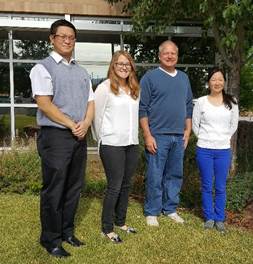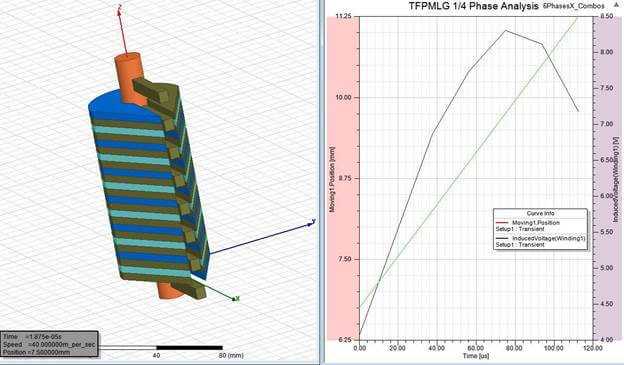
AirLoom Energy (from left to right): Mookwon Seo (engineer), Olivia Lim (engineer), Robert Lumley (president), Blossom Ko (operations). Additional staff (not pictured): Lance Goode (systems administrator), Josh Hamblin (engineer)
Energy innovation comes in many forms, as we at AirLoom Energy are proving with our revolutionary design of an alternative to the wind turbine. AirLoom Energy is a startup wind energy company housed at the incubator program (WTBC) at the University of Wyoming, home of the Cowboys football team and big, BIG wind. We were recently awarded an SBIR grant from the National Science Foundation to support the prototype development of our novel AirLoom wind power generation technology, a milestone that can be credited in large part to support received through the ANSYS Startup program.
Gliding around a track
After analyzing the physics of the industry-standard horizontal axis wind turbine technology, we turned the design on its ear by completely rethinking its geometry. Instead of the traditional design of three rotors radiating from a hub, the patented AirLoom has gliders that travel around an oval track, capturing energy through translational motion. The entire structure is tethered by bridles that use tension to combat downwind forces, much like staking a tent in the great outdoors. This potentially game-changing design is flexible in configuration and height, and can be constructed at a 15x reduction in cost and a 23x decrease in weight compared to a traditional wind turbine, making it suitable for a vast number of mobile (emergency, defense) and utility-scale installations.
Of course, we faced a lot of challenges on the way to developing this technology. One of the more complex issues was how to get power out of the device. We considered three options:
- An on-board generator (e.g., propellers, or a generator interacting with rack and pinion)
- A ski lift model (with the gliders pulling the cable)
- A linear generator (similar to a maglev train)
Our top choice — a linear generator — has a topology cost of $1 million per mile to build, which is beyond our budget. In researching alternatives, we came across the transverse flux permanent magnet linear generator. However, a leading expert in the field told us that there were no known analytical models in existence that fit our specifications, and developing one would require at least three months of full-time, highly specialized work. This would involve scoping out the project in full at the beginning, allowing additional time for modifications, and finding the funds to hire a remote contractor. On top of all that, we were not completely confident that the result would be accurate or would fully meet our needs.
The simulation solution
So instead, we took our nascent idea, created a basic geometry and imported it into ANSYS Maxwell. After a week, we had a working baseline model; we then used parametric studies to run 6,000 versions of the basic geometry. This was the result:
We call it the “Twisted Falcon” as from certain angles, we thought it looked like a twisty version of the Millennium Falcon from Star Wars.
Each glider on the AirLoom is attached to a Twisted Falcon. Adjacent to the track is a solid copper bar which serves as the motor winding. The gliders induce power in the winding, and the winding voltage adds in series.
Using ANSYS Maxwell, we can iteratively and interactively optimize the Falcon design’s geometry, cost, and other variables, and devise changes and improvements as the overall design of our wind capture device is refined. Plus, Maxwell enables us to validate that our device will actually function in the real world, which has been a crucial point in our interaction with funders.
With the help of the ANSYS Startup Program, we were able to develop a prototype of a transverse flux permanent magnet linear generator that matched our specifications, in less time and at lower cost than predicted. What more could a startup company ask for?
Filed Under: News




